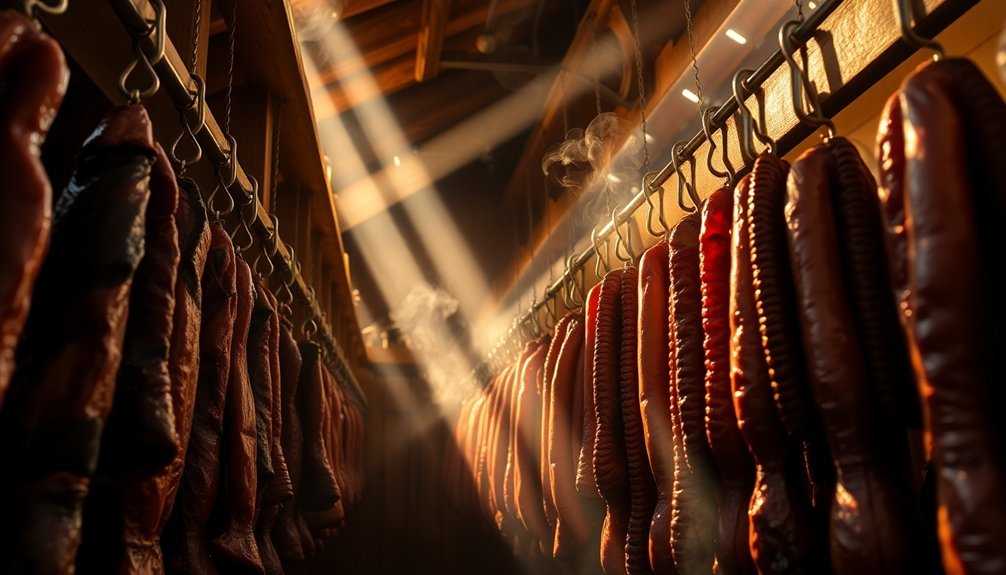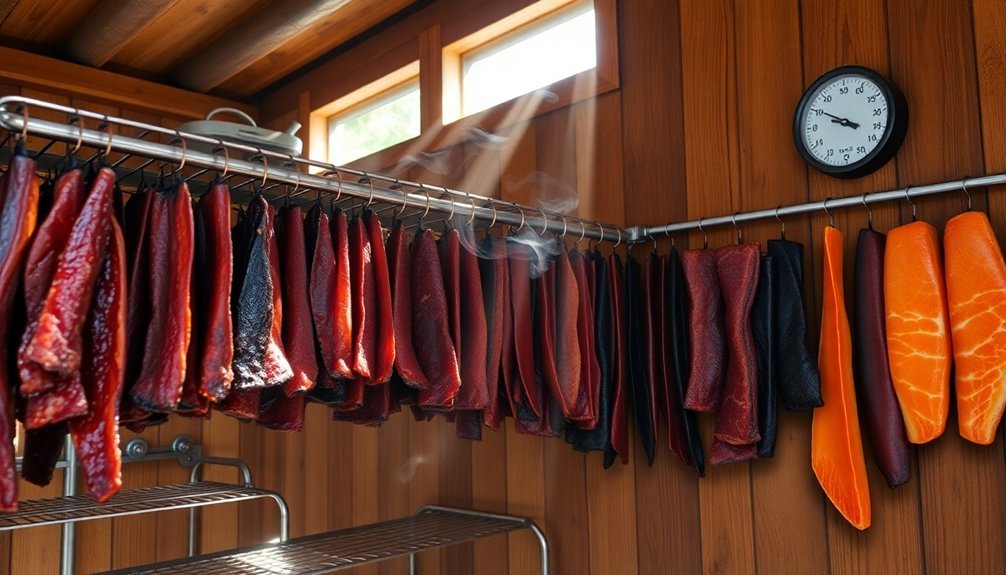To smoke and store meat long-term, you'll need to start with high-quality cuts and the right hardwoods like oak, hickory, or fruit woods. Keep your smoker temperature between 225-250°F for hot smoking, which is safer than cold smoking. Once smoked, cool your meat to refrigeration temperature before vacuum sealing in portion-sized packages. Label everything with contents and dates, then store in your freezer below 0°F for ideal preservation. When sealed properly, smoked meats can last 2-3 years frozen, with beef lasting longest and poultry up to 2 years. The journey to perfectly preserved smoked meats involves several critical steps and techniques to master.
Understanding Wood Selection for Preservation

When selecting wood for meat smoking, choosing the right type makes all the difference in achieving proper preservation and flavor. You'll want to focus on hardwoods, as they're specifically designed for smoking due to their slow-burning properties and ability to produce quality smoke. Oak, hickory, and fruit woods like cherry and apple are your best options for different types of meat. Traditional barbecue styles often rely on hickory wood for its robust flavor profile.
You'll need to avoid certain woods that can ruin your preservation efforts. Don't use softwoods like cedar, pine, or spruce, as their high resin content creates bitter smoke that can make your meat inedible.
Stay away from wood that's powdery, rotten, waterlogged, or too green, as these conditions affect smoke quality and preservation.
For ideal results, match your wood to your meat type. Use oak or hickory for beef and pork, while fruit woods work better for poultry and fish. You can also mix different woods to create balanced flavors – try combining hickory with cherry for a blend of strong and mild smoke.
Remember to maintain proper temperature control around 250°F and guarantee good smoke circulation for even preservation and seasoning.
Meat Preparation and Safety Measures
Prior to smoking any meat, proper preparation and safety measures are vital for success. You'll need to start by selecting fresh, high-quality cuts that are free from contamination and properly trimmed. Look for cuts with good fat marbling for optimal flavor development and tenderness.
Always thaw your meat completely in the refrigerator before smoking, as frozen meat won't reach safe internal temperatures efficiently.
When seasoning, you'll want to match the right marinades or dry rubs to your specific cuts. Keep meat refrigerated during marination, and if you're using the marinade for basting, either set aside an unused portion or boil the used marinade to eliminate bacteria.
You must prevent cross-contamination by using separate cutting boards and utensils for raw and cooked meats. Clean and sanitize all equipment thoroughly, and keep raw meats away from other foods during preparation and smoking.
Temperature control is critical for food safety. Maintain your smoker between 225°F and 300°F, and use reliable thermometers to monitor both the smoker and meat temperatures.
Cook beef, pork, lamb, and veal to 145°F with a 3-minute rest time, ground meats to 160°F, and poultry to 165°F to guarantee safe consumption.
Smoking Equipment Setup and Control

Successful meat smoking begins with proper equipment setup and precise control measures. You'll need to select a smoker that fits your space and budget, ranging from basic charcoal units to sophisticated models. Whether you choose electric, hardwood, or charcoal-fueled smokers, proper temperature control is essential for ideal results.
| Equipment Type | Temperature Range | Best For |
|---|---|---|
| Charcoal Smoker | 200-250°F | Traditional smoking, rich flavor |
| Electric Smoker | 200-275°F | Consistent temperature, beginners |
| Pellet Smoker | 180-500°F | Versatility, automation |
| Box Smoker | 200-275°F | Large capacity, commercial use |
To set up your smoker, start by lighting the charcoal in a chimney starter for about 15 minutes. Preheat to 225-250°F before adding meat. You'll need two thermometers: one for smoker temperature and another for meat's internal temperature. Installing an additional thermometer helps avoid opening the smoker unnecessarily, which disrupts temperature stability. Control airflow using vents and dampers, and maintain humidity with a water pan. Place wood chips or chunks on hot coals for smoke generation, but don't overdo it. Remember to guarantee proper smoke circulation by avoiding overcrowding and maintaining consistent ventilation throughout the smoking process.
Cold Smoking Versus Hot Smoking
Two distinct smoking methods dominate meat preparation: cold smoking and hot smoking. While both methods infuse meat with smoky flavors, they serve different purposes and require different approaches to food safety.
Cold smoking occurs at temperatures below 90°F and doesn't cook the meat. You'll need to cure your meat before cold smoking to prevent bacterial growth, as the meat remains in the danger zone throughout the process. This method can take days or even weeks but results in deeper smoke penetration.
You must cook cold-smoked meats to 160°F before eating them.
Hot smoking, operating between 225°F and 250°F, both cooks and flavors your meat simultaneously. You won't need to cure the meat beforehand, and it's safe to eat immediately after smoking. The process typically takes several hours to a day, producing a cooked, smoky flavor that's less intense than cold smoking.
Your choice between methods should consider safety factors. Hot smoking is safer due to its high temperatures killing harmful bacteria.
If you're planning to cold smoke, you'll need to follow strict curing procedures and temperature control to avoid dangerous pathogens like botulism and listeria.
Storage Container Requirements

When storing your smoked meats, you'll need airtight containers or vacuum seal bags that meet food-grade specifications to prevent bacterial growth and maintain freshness.
Your containers must be able to withstand temperatures no higher than 64°F (18°C), and vacuum seal bags should be at least 3-mil thick with proper heat-sealing capability.
Whether you choose rigid containers or vacuum bags, make sure they're specifically designated for meat storage and haven't been used for other purposes that could lead to cross-contamination.
Airtight Container Selection Guide
Proper storage containers are essential for maintaining the quality and safety of your smoked meats. When selecting containers, you'll want to focus on materials that offer durability, temperature tolerance, and chemical resistance to protect your smoked meats from spoilage.
Look for containers with airtight seals that can withstand both refrigeration and freezing temperatures. The material should be water-resistant and shouldn't react with your smoked meats or transfer unwanted flavors.
Choose stackable containers in various sizes to maximize your storage space and accommodate different quantities of meat. Your containers should have clear labeling areas so you can track storage dates effectively.
Select options that are easy to clean and maintain, with simple sealing mechanisms that create reliable airtight seals. Transparent or semi-transparent containers will help you identify contents without opening them.
Consider containers that can maintain consistent temperatures and control humidity levels. They should be able to protect your meats from light exposure when necessary.
For ideal results, store your containers in environments no warmer than 64°F (18°C), and choose designs that minimize the need for frequent opening and closing.
Vacuum Seal Bag Specs
Selecting vacuum seal bags with the right specifications is essential for preserving your smoked meats. You'll need bags that are puncture-resistant and free from harmful chemicals to guarantee your meat stays protected throughout its storage period.
Choose bags that are slightly larger than your portions to allow adequate space for a complete seal without stretching or tearing.
When you're packaging moist or high-moisture content meats, opt for specialized bags designed to handle excess liquid. These bags help prevent seal failures and maintain the quality of your smoked meats.
Before sealing, you'll want to double-check that one end is properly sealed before proceeding with the vacuum process.
You can extend your smoked meat's storage life considerably by using proper vacuum sealing techniques. For beef, you'll get up to 3 years in the freezer, while poultry can last up to 2 years.
Pork and lamb will stay fresh for up to 2 years when properly vacuum sealed and frozen. Remember to label each bag with the contents and date, making it easier to track storage duration and maintain a proper rotation system.
Vacuum Sealing Smoked Meats
For preserving your smoked meats, vacuum sealing stands out as the most effective storage method. This technique prevents freezer burn, maintains flavor, and guarantees excellent reheating results.
You'll find that vacuum sealing preserves the meat's juicy texture while reducing waste compared to traditional aluminum foil wrapping.
To vacuum seal properly, you'll need a high-quality food vacuum sealer and BPA-free, multi-layered bags. If you're sealing ground meats, pre-freeze them for 1-2 hours to prevent compression. For poultry, either pre-freeze or use a paper towel to absorb excess moisture before sealing.
Your vacuum-sealed smoked meats will last 6-12 weeks in the refrigerator and up to 2-3 years in the freezer.
When it's time to reheat, you've got two reliable options. You can use the water bath method – simmer the sealed package at 190°F until it reaches an internal temperature of 155-165°F. Alternatively, reheat in your oven at 275°F, covered loosely with foil, until reaching the same internal temperature.
Remember to thaw frozen meat in your refrigerator overnight before reheating.
Extended Shelf Life Storage Methods

To get the longest possible storage time from your smoked meats, you'll want to use both vacuum sealing and freezer storage methods.
Vacuum sealing removes air that could cause freezer burn and flavor deterioration, while storing your sealed meats at temperatures below 0°F will greatly extend their shelf life.
For best results, vacuum seal your smoked meats in portion-sized packages and freeze them immediately after they've cooled to refrigeration temperature.
Vacuum Sealing Smoked Meats
Proper storage of smoked meats starts with vacuum sealing, a method that dramatically extends shelf life and preserves flavor. You'll need a vacuum sealer and specially designed bags to create an airtight environment that prevents oxidation, freezer burn, and bacterial growth.
Before sealing, let your smoked meats cool to room temperature and pat them dry to avoid damaging your vacuum sealer. Portion your meats into meal-sized amounts, then place them in vacuum-seal bags, leaving adequate space at the top for a proper seal. Use textured bags and double-seal the ends for maximum protection.
You'll see significant benefits from vacuum sealing your smoked meats. In the refrigerator, they'll last 2-3 weeks, while freezer storage extends to 6-12 months. The sealed environment maintains moisture, tenderness, and nutritional value while preventing freezer burn and off-flavors.
For delicate meats, consider using a chamber vacuum sealer to avoid forcing out liquids during the process.
Don't forget to label your sealed packages with contents and dates for easy management. The space-efficient storage will keep your smoked meats fresh and ready for future meals.
Freezer Storage Best Practices
When storing smoked meats long-term, your freezer becomes your most valuable preservation tool. To maximize your smoked meat's shelf life, you'll need to properly wrap and package it before freezing.
Start by tightly wrapping your meat in plastic wrap, then place it in a resealable freezer bag, squeezing out as much air as possible to prevent freezer burn.
For ideal organization, label each package with the contents and date, allowing you to track storage times and use older items first. You can expect your smoked meats to maintain quality for 3-6 months when stored at 0°F (-18°C) or below.
If you're planning to store different types of meat, remember that storage times vary – whole cuts of beef can last 4-12 months, while processed meats like sausages should be used within 1-2 months.
When it's time to use your frozen smoked meat, always thaw it in the refrigerator, never at room temperature. Once thawed, use the meat promptly or refreeze it if necessary.
For extra protection against freezer burn, consider using airtight containers in addition to wrapping, and maintain consistent freezer temperatures to guarantee safe, long-term storage.
Frequently Asked Questions
Can Smoked Meat Be Safely Frozen and Thawed Multiple Times?
You can safely refreeze smoked meat if you've thawed it in the refrigerator, but avoid multiple cycles as it'll reduce quality. Don't refreeze if you've thawed at room temperature – that's unsafe.
How Do Different Altitudes Affect Smoking Times and Temperatures?
At higher altitudes, you'll need to increase cooking times by 5-10% due to lower air pressure. You should monitor temperatures closely and adjust your smoker's heat, as reduced oxygen affects both smoke production and temperature maintenance.
What Signs Indicate Smoked Meat Has Gone Bad During Storage?
Watch for these key spoilage signs: off-putting sour or ammonia smells, slimy or sticky texture, unusual discoloration, and any mold growth. If you notice these indicators, don't consume the smoked meat.
Can Previously Frozen Meat Be Smoked for Long-Term Storage?
Yes, you can smoke previously frozen meat for storage, but you'll need to thaw it properly first. While the texture may differ slightly, if you follow proper smoking temperatures and safety guidelines, it's perfectly feasible.
Do Different Meat Grades Impact the Final Storage Life?
Yes, higher grade meats will give you better storage life. You'll find that premium grades with less moisture and better marbling smoke more effectively and stay fresh longer due to their superior initial quality.
In Summary
You've now mastered the essentials of smoking meat for long-term storage. By selecting the right wood, maintaining proper temperatures, and using appropriate storage containers, you'll preserve your smoked meats safely. Remember to always vacuum seal your finished products and store them in cool, dark places. Whether you're cold smoking or hot smoking, these techniques will help you enjoy your preserved meats for months to come.





Leave a Reply